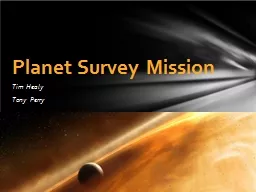

Introduction Finding Planets Pulsar Timing Astrometry Polarimetry Direct Imaging Transit Method Radial Velocity Selecting Planets Recap What else do we want to know Proposed Plan Outline ID: 745818
Download Presentation The PPT/PDF document "Tim Healy Tony Perry Planet Survey Missi..." is the property of its rightful owner. Permission is granted to download and print the materials on this web site for personal, non-commercial use only, and to display it on your personal computer provided you do not modify the materials and that you retain all copyright notices contained in the materials. By downloading content from our website, you accept the terms of this agreement.
Slide1
Tim HealyTony Perry
Planet Survey MissionSlide2
Introduction
Finding PlanetsPulsar TimingAstrometry
Polarimetry
Direct ImagingTransit MethodRadial VelocitySelecting PlanetsRecapWhat else do we want to know?Proposed Plan
OutlineSlide3
IntroductionSlide4
(NASA)Slide5
Finding PlanetsSlide6
Pulsar Timing Method
First exoplanet confirmation! (1992)Poor candidates for life
Wolszczan
and Frail, 1992Slide7
Precisely measure
a star’s position over
time
Mutual center of mass (barycenter)Successful in characterizing binary star systemsInaccurate claims of ‘unseen companions’
Not useful unless planet is massive
G
ood as a complementary technique
AstrometrySlide8
Un-polarized starlight
When the light reflects of a planet’s atmosphere, it becomes polarized by interacting with the molecules in the atmosphereAnalyze light in search of polarization
N
o planets found using this methodPolarimetry
University of HertfordshireSlide9
Land-Based Direct Imaging
Technological AspectsLarger MirrorsAtmospheric Distortions
Adaptive Optics (e.g. Keck)
Glare from host star Coronograph (e.g. Gemini Planetary Imager)> 5 AUOptical and Near IR spectraResultsPotentially useful for finding life
Keck II w/laser guide (CASA)
Simulation of
Coronograph
, (GPI)Slide10
Difficult to directly detect planets (extremely faint light sources)
Low Earth orbit in 1990
View the near ultraviolet, visible, and near infrared
Outside the distortion of Earth’s atmosphere (no background light)Ultra-Deep Field image2006 - Sagittarius Window Eclipsing Extrasolar Planet Search (SWEEPS)16 extrasolar
candidate planets discovered
W
hen extrapolated, strong evidence of about six billion Jupiter-sized planets
Direct Imaging – Hubble Telescope
http://www.youtube.com/watch?v=HAWMa_YEuKI
(NASA)Slide11
Dip in flux ~10^-5
Space-basedMass, periodT, habitability
Transit Photometry Method
(NASA)http://www.youtube.com/watch?v=vjdxJQj4QHYSlide12
Transit Method (Kepler Mission)
Looking for terrestrial planets in habitable zones
Launched 3/7/2009
Solar neighborhood-like regionOrbit:Earth-trailing, (372.5 days)Off-ecliptic6 year mission3 transits for significanceFollow-up ObservingGood start to look for life
Kepler
(NASA)Slide13
2321 candidates
around 1790 stars61 confirmed(2/27/12)
2321 candidates
around 1790 stars
61 confirmed
(2/27/12)
Blue are habitable candidates
48
canidates
1
confirmed
(Kepler 22b)Slide14
Similar to Astrometry
Radial velocity calculated from displacement in parent star’s spectral lines due to the Doppler effectModern spectrometers can detect velocity variations 1 m/s or less
High Accuracy Radial Velocity Planet Searcher (HARPS)
Most productive planet hunting technique by farWhen used in combination with the Transit Method, the planet’s true mass can be estimatedRadial Velocity (Doppler Spectroscopy)Slide15
Surveyed 102 red dwarfs
Thought to make up ~80% of the stars in our galaxy
40% of all red dwarf stars have a super-Earth orbiting the habitable zone
Estimated tens of billions of these planets exist within the Milky Way
S
tellar eruptions, flares
Radial Velocity - HARPS
m
snbc
- Artist rendition of sunset on super-Earth
Gliese 667 CcSlide16
Selecting PlanetsSlide17
Compiled Results
Catalog of planets (mass, period, host star)
Lunine
et al., 2009Slide18
Open Questions
Rocky or gas giant
Atmosphere
Orbit stabilityPresence of:WaterMethaneCarbon DioxidePlate TectonicsSatellite(s)Slide19
Proposed PlanSlide20
Astronomer
median annual wage: $95,500Mission cost: $1 mil per year
Utilize two most productive planet searching techniques
Transit Method (Kepler)Radial Velocity (Doppler)Kepler - mission cost for entire life cycle is ~$600 millionDoppler - ESO 3.6 m telescope cost is $41.7 million (HAPRS was installed in 2002 on this telescope)James Webb Space Telescope – 2018 launch
date
ELT, first light 2020s
Proposed PlanSlide21
Questions?